Working with Fur
Home >> Shade, Light & Render >> Shader Tree Items >> Fur Material >> Working with Fur


Working with Fur in MODO couldn't be easier. Simply select some polygons, create a material tag for your surface. Once you've tagged your surface, MODO automatically creates a material group item with its own material layer in the Shader Tree. Highlight this new material item and click on the 'Add Layer' popup above the Shader Tree, and select the 'Fur Material' item under 'Special' section of the popup menu. There is now Fur on your surface. Pretty easy. Of course there are lots of additional controls that allow the fur to be customized to look a lot of different ways.
The 'Fur Material' layer itself offers a good degree of control over your Fur with its various settings. In there the size of the fibers is set, and the length and kink, waviness, curls and the like. There are also some additional techniques related to working fur that, while covered elsewhere in the docs, would make it easier to have an overview of them all on a single page. Techniques, such as working with Guides, Implicit UVs & Gradients will allow users to really customize and control the look for their fluffy (or maybe frazzled) fur.
Guides
Guides are useful to control fur in various ways, such as controlling its bending direction, or length. In the 3D viewport representations they will actually look like sparse fur fibers over the target surface. The guides, for fur specifically, are curves made up from polylines, these being a special type of curve that look to be made up from multiple tiny line segments linked together. These types of curves are easier to manipulate with the styling tools and offer greater performance over regular spline curves. In all other respects they work and act just like the regular curves do.
Curves are set to control the fur fibers (especially useful in the case of longer hair styles) with the settings of the 'Fur Material'. As long as they share the same material tag as the fur material layer they'll work. To tag the polylines, simply select them in 'Polygons' mode and assign a tag same as for regular polygons. Hair guides can be drawn manually with the Pen tool, or regular spline curves can be created with the Curve, Bezier or Sketch tools and converted to Polyline curves with the 'Freeze' command (select the 'Polylines' option from the 'Freeze Curves As' control). Another thing to keep in mind when drawing curves as fur guides is the root of the curve needs to originate close to the surface the fur will grow from. It's easy to tell which side is the root, as a small circle is drawn around the root vertex for all curves.
Hair Guide Tool--
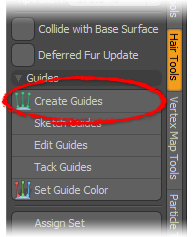
Manually creating guides can get tedious rather fast though. A much easier way to create them is using the 'Hair Guides' function in the Painting/Sculpting toolbox under the 'Hair Tools' subtab. The guides this tool creates inherit the material tag from the selected surface, so it is best to name your fur surface with a proper material before activating the tool. If your polygons aren't already selected, highlight the polygons you want your fur to grow from and keep them highlighted when activating the tool, the selection controls the growth area, limiting the guides only to the selected geometry.
If you want to apply it to an area based on an existing materials, the polygons selection that defined the area can be recalled using the Statistics Panel and selecting the material by name under the 'Material' section of the panel. Once you have your polygon selection and have activated the tool, you get this properties panel allowing you to click in your 3D viewport to actually generate the fur guides. LMB+clicking and hauling left of right will grow or shrink the guides in length. You can also manually set the length directly in the tool properties. The use of the tool is covered in-depth on its own page of the documentation, along with coverage on some extra tool to enhance the guide creation process.
Styling
Much like the sculpt and painting tools, MODO offers a variety of tools meant specifically for styling your fur. Located in the 'Paint' tab of the default workspace, the hair tools tab (along the edge of the toolbox) give you everything you need for combing and sculpting fur into the proper do. The tools all work double duty styling both guides, and when 'Edit Fur Map' is selected in the tools properties, you can paint on image maps meant to control the styling of regular fur as well. Image maps can control many different aspects of your Fur Material, such as Length, Density, Direction, Curling etc. All are available when right clicking in the 'Effect' column of any procedural or image map texture layer. Yes, even procedurals can control your fur material layer, but we'll get into that further below.
Hair Styling Tools--

The Hair Tools tab offers several brushes for styling your fur in a variety of ways (covered in detail in this section). They work just like the painting and sculpting brushes, where their performance can be enhanced by using a pressure sensitive tabled to drive the strength values dynamically. The tools are multi-purpose, in that they can be used to affect the guide curves, or they can be used to control the fur indirectly using a Fur Vector Map, the application depends on the 'Edit Fur Map' setting control in each tool.
The editing of the fur guides is pretty straightforward and intuitive, just selecting a Hair Tools brush and dragging it over some guides will modify them (Guides must be visible on a foreground layer). How they are modified is based on the tool selected (obviously). The higher the Offset amount of the brush, the stronger the influence the brush has over the adjustment. This allows users to make big changes, or subtle tweaks using the same tools.
When not using guides (such as working on short fur styling, say for a cat or other small animal) the use of image based vector maps can simultaneously control the length and bend direction for the fibers as well. For ease of setup, some preset scripts have been created for the most common fur styling tasks - 'Add Fur Vector Texture', 'Add Fur Direction Texture' and 'Add Fur Length Texture' (found at the bottom of the 'Hair Tools' toolbox). These scripts when activated, will automatically create a blank image, and apply it with the appropriate 'Effect' setting in the shader tree for your Fur Material. Of course a Fur Material item will need to be present first. Once the correct image has been created, users can use any of the available brushes to control the fur layer. When editing them this way, users should see the GL preview fibers created by the Fur material itself move and change as the brush strokes are applied.
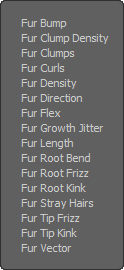 Texturing Fur with Shader Tree Layers
Texturing Fur with Shader Tree Layers
Fur layers take all their color and shading information from the Material item in the same layer group. Set the material to red and you'll get red fur, set it to 50% transparent and your fur will become transparent. Most fur and hair has a great deal of variation to it in length color and how it grows. The Fur Material has jitter setting to control the growth part. Texture layers are a great way to control how the fur looks and add that necessary variation. Texture layers can also add specific, highly accurate control to fur styling and coloration. Several effect channels are available that can be applied to both procedural and image map texture layers.
By adding a blank image to your material group (Images tab > New Image) and setting the layer to your intended effect, you can use any of the painting tools directly in MODO to adjust, color and style your fur (you'll see a little paintbrush icon in the eye column of the shader tree letting you know that's the layer you're painting on). Remember that the fur material pulls its shading from the Material layer, so all the ways you can adjust your material with texture layers are also available to you Fur layer. Apply an image map as diffuse color, and each fiber will pull its color from the underlying texture layers color.
Gradients--
Gradients are also useful for Fur layers. Outside of all the ways a gradient normally controls a layers surfacing parameters, you can use gradients to control each fibers along its length by applying the 'Fur Parametric Length' setting as the Gradient's 'Input Parameter'. Now, whatever you set as the 'effect' for the gradient --Diffuse Color, Transparent Amount, whatever effect you'd like to control will apply from a fibers root, at 0% to the tip at 100%, regardless of the length. Maybe you just want to mix up the colors of the fibers, or simulate a salt and pepper type effect. That's possible with gradients as well. As each fiber is created by MODO, it is assigned a random value between 0 and 1. Setting the gradients input parameter to 'Particle ID' allows you to add some randomization to the individual fibers with ease as it takes that random number and pulls the color from the gradient based on its value.
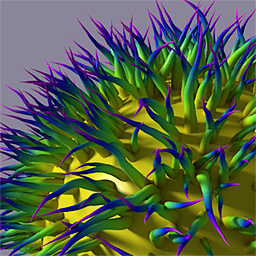 A 'Fur Parametric Length' Gradient applied along the length of the fur. | 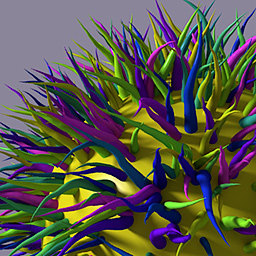 A 'Particle ID' Gradient applied varying the individual colors. |
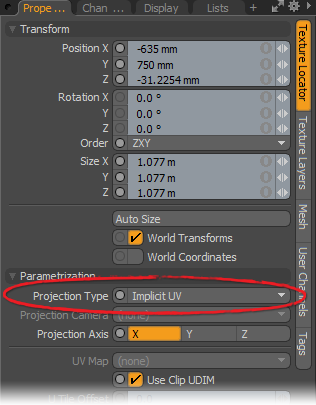 Implicit UVs--
Implicit UVs--
UV maps are a great way to control how images are applied to surfaces, so you might be wondering if it is possible to apply image maps to individual fibers as well. Luckily, there is. When you have your fur type set to 'Strips' (remember there are 2 types -Cylinders and Strips) images will map to each strip individually, when fur type is set to cylinders, image will wrap around the fiber cylindrically. Images can also be mapped this way for the 'Billboard' features. Applying images for fur has lots of uses, simulating feathers, making photo real grass to name two of them. One can simply add a texture to individual fibers by adding an image map layer to the material group. In the Texture Locators properties you want to select 'Implicit UV' as the projection type within the texture Locator (seen here on the right). That's it, now your image will be applied to each and every fiber as it renders.
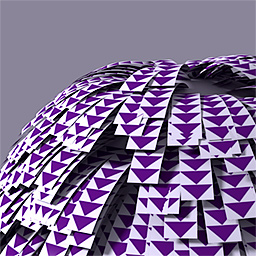
Material Layers and Multi layered Fur
Each Fur layer pulls its shading from the material layer, but there are probably lots of instances where a user would want the fur material to be different from the underlying surface. That's possible as well. Here's a quick rundown of how to do it.


